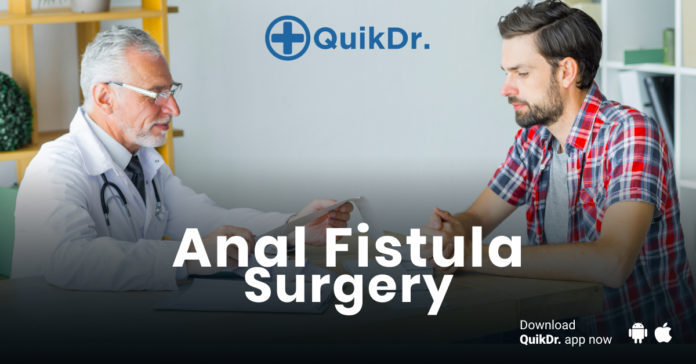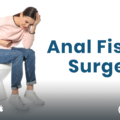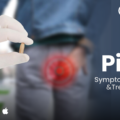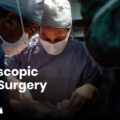An anal fistula is an anomalous channel that forms connecting the interior of the anus to the outer skin. Typically, it arises in the upper region of the anus, where the anal glands are located. The formation of a fistula is often a result of an infection in these glands, known as a perianal abscess, leading to drainage that gives rise to the abnormal passageway.
Surgical intervention for anal fistulas varies in complexity, contingent on the nature of the fistula. The most common, simple anal fistulas, known as intersphincteric fistulas, involve a small amount of muscle and are typically treated in a single operation. Conversely, more intricate fistulas may necessitate staged surgical procedures.
Anal Fistula
For Simple Fistulas:
A simple fistula, characterized by minimal muscle involvement and no branching, is typically treated through a procedure called fistulotomy. This one-time surgical approach involves cutting through the roof of the fistula, allowing it to fill in from the bottom up. While this procedure is highly effective (approximately 95%), it may involve cutting a small amount of muscle, with the caveat that excessive muscle removal poses a risk to bowel control.
For Complex Fistulas:
Complex fistulas, which entail significant muscle involvement, branching, or heightened risk of surgical complications due to preexisting conditions, may require multiple surgeries. The following techniques may be employed:

- Seton Drain: A non-absorbable surgical thread, known as a seton, is looped through the fistula to keep it open for drainage. It can also facilitate slow cutting through the fistula tract to promote healing, prevent wound separation, and address local scarring. For chronic conditions like inflammatory bowel disease, the seton drain may be left in place indefinitely.
- Endorectal Advancement Flap: This method avoids cutting the roof of the fistula, preserving sphincter muscles. The surgeon removes infected tissue around the internal opening and covers it with a flap of healthy tissue from the rectum. While about 70% effective, there’s a risk of recurrence, and approximately 30% risk of sphincter muscle injury during the flap cutting.
- LIFT Procedure: LIFT, or “ligation of intersphincteric fistula tract,” involves closing the part of the fistula passing between sphincter muscles. This is typically done with stitches, followed by the removal or scraping of the entire fistula tract. While less effective than fistulotomy (about 75%), it carries a lower risk of sphincter muscle damage.

Fistula Surgery Cost
The cost of laser treatment for an anal fistula can vary widely depending on several factors, including the geographic location, the specific type of laser procedure used, the healthcare facility, and the individual patient’s insurance coverage. In many cases, the cost of medical procedures is influenced by the overall healthcare system and practices in a particular country.
Typically, the expense for laser piles surgery in India can vary from ₹ 40,000 to ₹ 50,000, with an average cost falling within the range of ₹ 44,000 to ₹ 47,000.
Anal fistula symptoms
Anal fistulas can cause a variety of symptoms, and the severity and type of symptoms can vary depending on the characteristics of the fistula. Here are common symptoms associated with anal fistulas:
- Pain: Pain is a common symptom of anal fistulas, especially during bowel movements. The pain may be sharp, throbbing, or constant.
- Swelling and Redness: The area around the anus may be swollen and red due to inflammation associated with the fistula.
- Discharge: An anal fistula often produces a discharge, which may be pus or blood. This discharge can stain underwear and may have a foul odor.
- Itching or Irritation: The skin around the anus may become itchy or irritated, partly due to the constant moisture and discharge associated with the fistula.
- Fever: In some cases, individuals with anal fistulas may experience a low-grade fever, particularly if there is an associated infection or abscess.
- Painful Bowel Movements: Passage of stool through the fistula tract can be painful, leading to discomfort during and after bowel movements.
- Recurrent Abscesses: Anal fistulas may be associated with abscesses, which are painful collections of pus. Recurrent abscesses may be a sign of an underlying fistula.
It’s important to note that not everyone with an anal fistula will experience all of these symptoms, and the severity can vary. If you suspect you have an anal fistula or are experiencing any of these symptoms, it is crucial to consult with a healthcare professional. Anal fistulas typically require medical attention, and a healthcare provider can diagnose the condition and recommend an appropriate treatment plan, which may include medications or surgical intervention. Ignoring symptoms or attempting self-treatment may lead to complications and worsening of the condition.
Causes of anal fistula
Fistulas may manifest in various parts of your body, either establishing connections between distinct organs or forming passages from an organ to an opening in the skin. Typically, they arise when your tissues experience prolonged inflammation resulting from injury or illness. Over time, persistent inflammation and infection can lead to the gradual erosion of nearby tissues, particularly when the drainage of pus becomes necessary. This erosion process can give rise to a channel linking the wound with adjacent tissues.
Complications of an anal fistula
If left untreated, a fistula typically does not resolve on its own, leading to potential long-term complications, including:
- Persistent infection: A fistula originating from an abscess or infection may perpetuate the active infection. Although the infection might appear to subside at the initial site, it can return, forming a new abscess and causing renewed pain. In some cases, the fistula may seem to be in the process of healing, closing at the opening, only to reopen due to recurring infection and drainage in a cyclic pattern.
- Fistula extension: In rare instances, a chronic fistula may extend in new directions, creating additional branching channels and openings in the skin. Repairing these complex fistulas can be more challenging.
- Cancer: Anal cancer has been sporadically detected in longstanding anal fistulas persisting for years. Chronic inflammation and erosion represent known risk factors for the development of cancer.
Diagnosis
Healthcare professionals can typically identify the majority of anal fistulas through a physical examination, although there are instances where the external opening may be closed. In order to locate the internal opening within your anus, which may necessitate anesthesia due to potential discomfort, your provider may need to examine you more thoroughly. If the examination of the inside is too painful, your healthcare provider might opt to conduct the examination in an operating room under sedation.
In the quest to identify the internal source of the fistula, your healthcare provider may employ a lighted scope, such as an anoscope or proctoscope (a longer scope for visualizing the rectum). Occasionally, they may inject hydrogen peroxide into the external opening to pinpoint the infection at the origin of the fistula. The interaction between peroxide and the infection will result in bubbles or foam at the site, confirming the presence of the fistula’s internal source.

Treatment for an anal fistula
The majority of anal fistulas necessitate surgical intervention for resolution. Spontaneous healing often leads to recurrent infections and reopened fistulas. Yet, in cases where the fistula results from inflammatory bowel disease and remains uninfected, there is a chance of healing through medical treatment. In such instances, your healthcare provider might explore options like immunomodulator therapy, such as infliximab, before considering surgery for these particular fistulas.
Recovery of Anal fistula
Anal fistula procedures are typically performed on an outpatient basis, allowing you to return home on the same day, although some individuals may require additional surgeries later. Upon discharge, you will be provided with prescription pain medication and self-care instructions, which may involve:
- Water and Fiber Supplements: To counteract the constipating effects of pain medications, your healthcare provider might prescribe fiber supplements. It’s crucial to take these supplements with ample water.
- Sitz Bath: A daily soak in a sitz bath, a warm and shallow bath for the anus, can help alleviate discomfort and expedite the healing process.
- Wound Management: Application of dressings to your wound to collect drainage is necessary, and regular changing of these dressings is important to maintain cleanliness.






